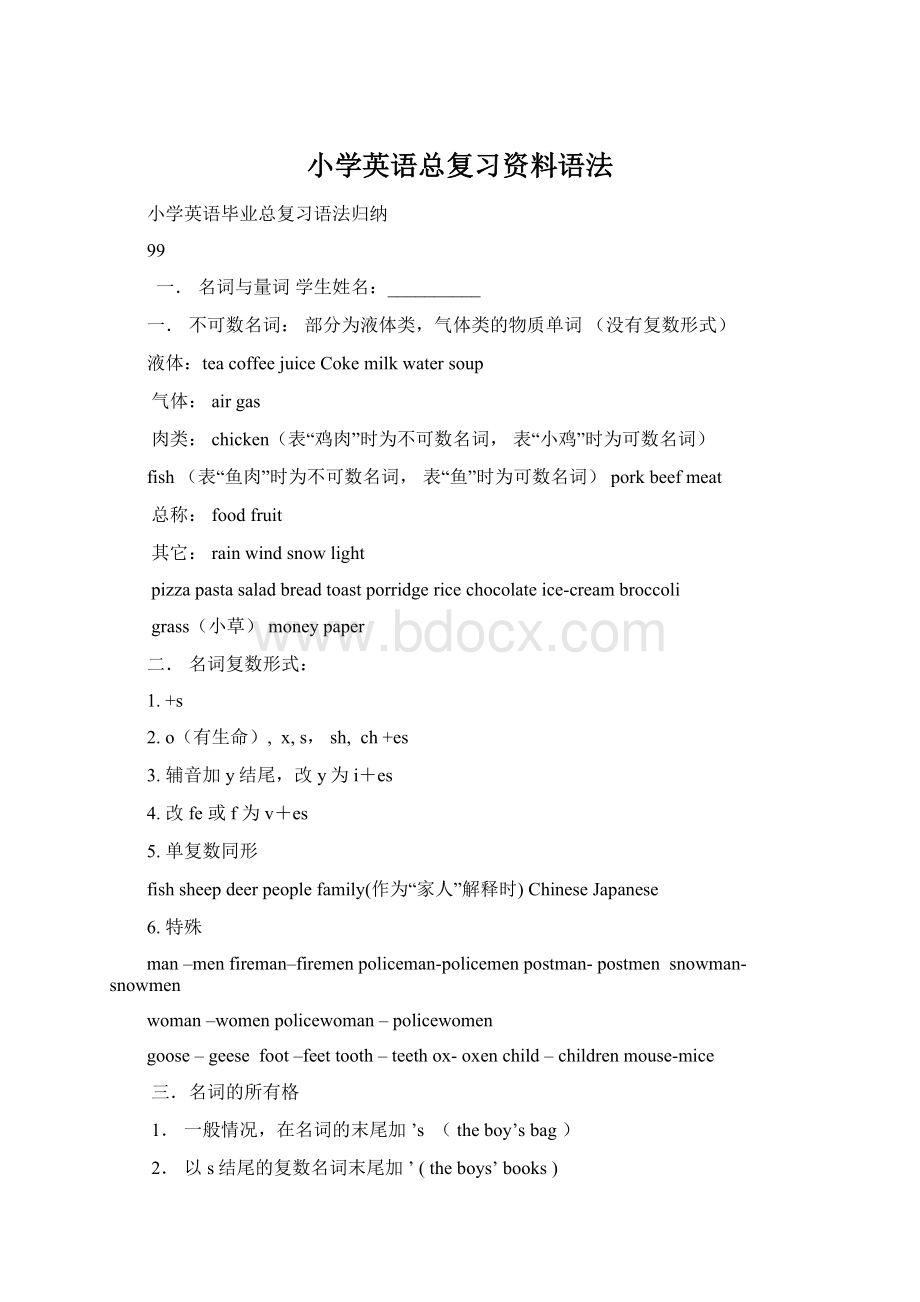 小学英语总复习资料语法.docx
小学英语总复习资料语法.docx
- 文档编号:5923279
- 上传时间:2023-01-02
- 格式:DOCX
- 页数:15
- 大小:27.10KB
小学英语总复习资料语法.docx
《小学英语总复习资料语法.docx》由会员分享,可在线阅读,更多相关《小学英语总复习资料语法.docx(15页珍藏版)》请在冰豆网上搜索。

小学英语总复习资料语法
小学英语毕业总复习语法归纳
99
一.名词与量词学生姓名:
__________
一.不可数名词:
部分为液体类,气体类的物质单词(没有复数形式)
液体:
teacoffeejuiceCokemilkwatersoup
气体:
airgas
肉类:
chicken(表“鸡肉”时为不可数名词,表“小鸡”时为可数名词)
fish(表“鱼肉”时为不可数名词,表“鱼”时为可数名词)porkbeefmeat
总称:
foodfruit
其它:
rainwindsnowlight
pizzapastasaladbreadtoastporridgericechocolateice-creambroccoli
grass(小草)moneypaper
二.名词复数形式:
1.+s
2.o(有生命),x,s,sh,ch+es
3.辅音加y结尾,改y为i+es
4.改fe或f为v+es
5.单复数同形
fishsheepdeerpeoplefamily(作为“家人”解释时)ChineseJapanese
6.特殊
man–menfireman–firemenpoliceman-policemenpostman-postmensnowman-snowmen
woman–womenpolicewoman–policewomen
goose–geesefoot–feettooth–teethox-oxenchild–childrenmouse-mice
三.名词的所有格
1.一般情况,在名词的末尾加’s(theboy’sbag)
2.以s结尾的复数名词末尾加’(theboys’books)
3.表示几个人共同拥有的东西,只在最后一个名字后加’s
如:
TomandBen’sbedroom(汤姆与本共同拥有的卧室)
4.分别拥有的东西就在每个名字后各自加’s
如:
Tom’sbedroomandBen’sbedroom(汤姆的卧室和本的卧室)
5.没有生命的东西的所有格通常用“…of+名词”的方法来表示。
如:
thecoverofthebook(书的封面)
注:
姓氏的复数形式前面加the表示“…一家人”
如:
theWhites(怀特一家人)
姓或名字后加所有格有时可以表示地点。
如:
Let’seatatJimmy’s(我们去Jimmy餐厅吃饭吧。
)
I’mgoingtoMissLin’s.(我准备去林老师家。
)
四.量词
1.aplateof(一盘…)7.abowlof(一碗…)
2.apieceof(一片/张…)8.abagof(一袋…)
3.apairof(一对/双…)9.aboxof(一箱…)
4.acupof(一茶杯…)
5.aglassof(一玻璃杯…)
6.abottleof(一瓶…)
注:
量词的后面+不可数名词(单数)/可数名词(复数)
如:
abagofriceabagofapples
当量词数量超过一时,量词也要跟着用复数形式。
如:
twoglassesofsomebottlesof
二.形容词与副词
(一)单音节及部分双音节单词的形容词及副词比较级与最高级变化规律:
1.直接+er/est
2.以e结尾+r/st
3.重读闭音节单词(通常以辅元辅结尾)双写末尾字母+er/est(如:
wetter,hotter,fatter)
4.辅音加y结尾改y为i+er/est
5.特殊(不规则)
(二)双音节(部分)与多音节单词形容词、副词比较级与最高级变化规律:
比较级最高级
more+原形most+原形
(三)修饰比较级的词:
much
alittle+比较级
alot
(四)表示“越来越…”
biggerandbiggerhappierandhappiermoreandmorelessandlees
moreandmoreslowlymoreandmorebeautifulmoreandmoreboring
(五)不规则的形容词词、副词比较级与最高级:
•wellbetterbest
•goodbetterbest
•manymoremost
•badworseworst
•farfartherfarthest
•littlelessleast
(六)部分双音节形容词、副词的比较级与最高级:
•slowlymoreslowlymostslowly
•crowdedmorecrowdedmostcrowded
•famousmorefamousmostfamous
•quicklymorequicklymostquickly
•patientmorepatientmostpatient
•excitedmoreexcitedmostexcited
•boringmoreboringmostboring
(七)其他
1.形容词修饰名词,常放在名词前。
(abeautifulgirl)
2.副词修饰动词,常放在动词后面。
(runfast)
3.两者之间用比较级,三者或三者以上通常用最高级。
如:
Whocanrunfaster,BenorTom?
Whocanrunfastest,Ben,Tom,orYongxian?
4.比较级的句子通常有标志词“than”。
5.最高级的句子通常有标志词“the”(形容词最高级才有,副词没有),表范围限制的介词“in、on、of”。
如:
Sheistheprettiestofthethree.(她是三个人当中最漂亮的。
)
Elephantsarethebiggestanimalsonland.
Herunsmostslowlyinhisclass.(副词的最高级前面没有“the”)
三.介词与连词
(一)介词
1.表时间:
at:
在几点
on:
在某一天
in:
在某个月、季节、学期、年
from…to…:
从…到….
for:
做事情做了多长时间,持续多久
during:
在…期间
2.表方位:
in,on,beside,under,behind,infrontof,near,between,opposite,against
里面上面旁边下面后面前面附近两者之间对面靠着
3.表地点:
at:
在…(后面加小的地点)(atschool,atthelibrary)
in:
在…(后面加大的地点)(inChina,inGuangzhou)
9.inthemorning/afternoon/evening在上午/下午/晚上
10.atnoon/night在中午/夜晚
11.closeto/nextto靠近…
12.ontheleft/right在左边/右边
13.fromtheleft/right从左边/右边
14.askfor…索取…
15.waitfor…等待…
16.onthefarm在农场上
4.介词短语
1leavefor离开到…
2startfor出发到…
3lookfor寻找…
4agreewith同意…
5catchupwith赶上…
6helpsb.with帮某人某事
7helpyourselfto随便吃..
8getto到达…
9
(二)连词
and:
和(并列关系)
or:
或者(选择关系)
but:
但是(转折关系)
when:
当…
then:
然后
before:
在…之前
after:
在…之后
because:
因为
so:
所以
if:
假如
四.代词、冠词与数词
(一)代词
人称
代词
我
你
他
她
它
我们
它/她/他们
主格
I
you
he
she
it
we
they
宾格
me
you
him
her
it
us
them
物主
代词
我的
你的
他的
她的
它的
我们的
它/他/她们的
形容词性
my
your
his
her
its
our
their
名词性
mine
yours
his
hers
its
ours
theirs
1.人称代词
主格:
一般在句子中做主语,放在动词前面。
(疑问句则放在动词后面)
如:
SheandIaregoodfriends.
Issheaclevergirl?
宾格:
一般在句子中做宾语,放在动词或介词后面。
如:
Givemeabook.
Iamwaitingforhim.
2.物主代词
形容词性物主代词:
修饰名词,放在名词前面。
(如:
mybook,theirteacher)
名词性物主代词:
后面不能加名词,可单独使用,常放在句子末尾或动词前面。
如:
Yourbookisbetterthanmine.
Mybookisinteresting.Hersisboring.(hers在这里意思为herbook)
(二)冠词
1.不定冠词a、an
1)表示一类人或事物,不具体指哪一个。
如:
Sheisateacher.
2)表示数量“一”。
如:
Ihaveacatandtworabbits.
3)用在固定搭配里。
如:
alotof,alittle,haveacold,takearest
4)元音发音开头的单词用“an”,辅音发音开头的单词用“a”。
(一般情况以a,e,io,u结尾的单词用“an”)
如:
anegg,anEnglishteacher,anapple
2.定冠词the
1)特指某个具体的人或事物。
(如:
Thebookonthetableismine)
2)已经提过的人或事物。
(如:
Ihaveacat.Thecatislovely.)
3)用在序数词、形容词最高级的前面。
(Iliveonthethirdfloor.Guangzhouisthebestcity.)
4)用在世界独一无二的事物前。
(thesun,themoon,theearth)
5)用在乐器前。
(playtheguitar,playthepiano)
6)
(三)数词
1.基数词:
表数量(one,two,three…)
2.序数词:
表顺序(first,second,third….)
一、二、三特殊记,first,second,third。
八去t,九去e,ve要用f替。
见y改为i和e,词尾加上th。
若是遇见几十几,只变各位就可以。
(first,second,third,eighth,ninth,fifth,twentiethforty-first)
五.动词
(一)情态动词:
can,could,may,must,need,will,would,should,+动原
can't,couldn’tmustn’t,needn’t,won’t,shouldn't+动原
1.情态动词表示说话人的语气与情态。
2.情态动词没有人称和数的变化。
如:
I/She/He/Theycanrun.
3.注意:
用must来提问,肯定回答用must,否定的回答多用needn’t.
如:
MustIborrowbookswithalibrarycard?
Yes,youmust.
MustIborrowbookswithanIDcard?
No.youneedn’t.
(二)be动词
be动词口诀:
1.在一般现在时中:
I用am,you用are,is连着he,she,it.
单数名词用is,复数名词全用are.
变疑问,往前提,句末问号莫丢弃。
变否定,更容易,be后not莫忘记。
疑问否定任你变,句首大写莫迟疑。
2.在过去时中:
I用was,you用were,was连着he,she,it.
单数名词用was,复数名词全用were.
(三)行为动词
1.行为动词主要表示主语的动作和状态。
如:
stand,come,die,go,run,sit,put,borrow,buy
2.行为动词可分为及物动词(vt.)和不及物动词(vi.)。
3.及物动词指的是后面能跟宾语的动词。
4.不及物动词指的后面不能跟宾语的动词。
五.一般过去时
1.一般过去时的定义:
表示过去发生的事情和动作。
2.动词由原形变为过去式的规律(即动词过去式):
1)+ed(如:
watched)
2)以e结尾+d(如liked)
3)重读闭音节单词(通常以辅元辅结尾)双写末尾字母+ed(如:
stopped)
4)辅音加y结尾的单词改y为i+ed(如:
studied)
5)不规则(及特殊形式):
(见六年级下册P90)
am-wasis-wasare-weredo-didfeel-feltget-gotgo-wenthave-had
say-saidsee-sawread-readcome-cameeat-atefly-flewblow-blew
3.一般过去时常用的时间状语:
justnow(刚才)
yesterday(昨天)
yesterdaymorning/afternoon/evening(昨天早上/下午/晚上)
lastmonth./week/year…(上个月/上个星期/去年)
thismorning/afternoon/evening(今天上午/下午/晚上)
…ago(…之前)
in2000(在2000年)
before/before…(以前/…以前)
4一般过去时的句型:
肯定句:
(动词用过去式)
Shewasathomeyesterdayevening.
Wewerebusyjustnow.
Hedidhishomeworklastnight.
Theyplayedfootballyesterday.
否定句:
(行为动词的否定:
didn’t+动原;be动词的否定:
wasn’t,weren’t)
Shewasn’tathomeyesterdayevening.
Weweren’tbusyjustnow.
Hedidn’tdohishomeworklastnight.
Theydidn’tplayfootballyesterday.
疑问句:
(行为动词的疑问句:
did+动原;be动词的疑问:
Was/Were…)
Wassheathomeyesterdayevening?
Wereyoubusyjustnow?
Didhedohishomeworklastnight?
Didtheyplayfootballyesterday?
Wheredidhegoyesterday?
Howdidyougotoschoolthismorning?
六.一般将来时
(一)一般将来时的定义:
表示将要做,打算做,准备做的事.
(二)一般将来时的结构:
1.begoingto+动词原形
(is/are/amgoingto+动词原形)
1)肯定句
Iamgoingtogotoschooltomorrow.
Heisgoingtoplayfootballthisafternoon.
Sheisgoingtodosomereading.
TheyaregoingtoseethewhitetigernextSunday.
WearegoingtosurftheNetthisevening.
Sallyisgoingtoswimthisafternoon.
Thegirlisgoingtogototheparkwithherfriendtomorrow.
2)否定句
isn’t/aren’t/amnot/goingto+动词原形
如:
Sheisn’tgoingtoswimtomorrow.
Theyaren’tgoingtoswimnextweekend.
3)特殊疑问句
Whatareyougoingtodo?
Howareyougoingtogetthere?
WhattimeisyourtraingoingtoleaveforHongKong?
Whattimeareyougoingtogotoschooltomorrow?
4)一般疑问句
Isshegoingtogotoschooltomorrow?
Yes,sheis./No,sheisn’t.
Areyougoingtoplayfootballtomorrow?
Yes,Iam./No,Iamnot.
AmIgoingtogettoschoolbybustomorrow?
Yes,youare./No,youaren’t.
2.will+动词原形
1).肯定句
Iwillgotoschooltomorrow.
Hewillplayfootballthisafternoon.
Shewilldosomereading.
TheywillseethewhitetigernextSunday.
2).否定句:
won’t+动词原形
3)一般疑问句
Willyougotoschooltomorrow?
Yes,Iwill./No,Iwon’t.
WillshesurftheNettomorrow?
Yes,shewill/No,shewon’t.
4)特殊疑问句
Whenwillyougetthere?
Whowillgowithyou?
Whatwillyoudoonholiday?
(三).一般将来时常用时间状语:
tomorrow,thedayaftertomorrow,this(next)morning/Sunday/week…
七.一般现在时
1.一般现在时的定义:
表示经常性、习惯性的动作或现在的状态特征。
2.一般现在时常见标志词:
never,sometimes,often,usually,always,seldom,every…
3.一般现在时基本句型结构:
第三人称单数
其他人称
肯定句
动词加s或es(does)
动词原形(do)
否定句
doesn’t+动词原形
don’t+动词原形
疑问句
does+动词原形
do+动词原形
4.当主语是第三人称单数时,一般现在时的动词变化的规律:
⏹1)一般情况加s,例如:
visit–visitstell–tellswork–workswave–waves
⏹2)以s,x,sh,ch,o结尾的动词,加es,例如:
wash–washeswatch–watchescatch–catchesteach-teaches
fix-fixesguess-guessesgo-goesdo-does
⏹3)以辅音字母加y结尾的动词,改y为i加es,例如:
fly–fliesstudy–studies
⏹4)特殊情况
have–has
5.当主语是第三人称单数时,一般现在时的特殊疑问:
⏹Whattimedoeshegetup?
Hegetsupatsix.
⏹Wheredoesshelive?
ShelivesinRenminRoad.
⏹Howdoeshegotowork?
Hegoestoworkbybus.
Whohandsinthehomework?
Jiamin.
Whosefriendpracticesthepiano?
Jane’sfriend.
⏹Whichschooldoesshestudyat?
ShestudiesatMo.2School.
6.当主语是第三人称单数时,一般现在时的肯定句,否定句和一般疑问句的变化,例如:
⏹Ieatdinneratsix.
⏹Heeatsdinneratsixtoo.
⏹Idon’teatdinneratsix.
⏹Hedoesn’teatdinneratsixeither.
⏹Doyoueatdinneratsix?
⏹Doesheeatdinneratsix?
八.现在进行时
1.定义:
表示动作正在进行。
2.现在进行时常用标志
- 配套讲稿:
如PPT文件的首页显示word图标,表示该PPT已包含配套word讲稿。双击word图标可打开word文档。
- 特殊限制:
部分文档作品中含有的国旗、国徽等图片,仅作为作品整体效果示例展示,禁止商用。设计者仅对作品中独创性部分享有著作权。
- 关 键 词:
- 小学英语 复习资料 语法
 冰豆网所有资源均是用户自行上传分享,仅供网友学习交流,未经上传用户书面授权,请勿作他用。
冰豆网所有资源均是用户自行上传分享,仅供网友学习交流,未经上传用户书面授权,请勿作他用。


 对中国城市家庭的教育投资行为的理论和实证研究.docx
对中国城市家庭的教育投资行为的理论和实证研究.docx
